Middleweight sportbike development has been a fiercely competitive game of one-upmanship among the Japanese Big Four. Dictated in part by the rules of supersport racing, orthodoxy has converged upon an in-line, four-cylinder 599cc engine. Honda, Kawasaki, Suzuki and Yamaha currently achieve this displacement with the exact same bore and stroke: 67mm x 42.5mm. With enormous R&D budgets and a vast network of factory and satellite race teams, development occurs at a rapid pace and new models are introduced every two to three years.
Sure, Triumph has racing in its bloodline, but lots of folks did lots of head scratching when it launched the TT600 salvo into this war zone in 2000. The small, scrappy British manufacturer was like David attempting to defeat a four-headed, deep-pocketed Goliath. When we compared the TT600 to four Japanese middleweight sportbikes (see Rider, September 2000), it got high marks for ergonomics, riding position and handling. But Triumph’s first-generation 599cc sportbike sank like a stone in the rankings because it had the lowest power, highest weight and problematic fuel injection.
Battered and bruised but still in the fight, Triumph released a much-improved middleweight in late 2002 with a new name, the Daytona 600. Styling was sharp-edged and distinctive, and early complaints were addressed, but continuing to go head-to-head, cc-to-cc was a losing battle. In 2005, Triumph broke out of the 600cc straightjacket and bumped displacement up to 646cc. If you can’t beat ’em, outsize ’em. And one year later Triumph finally took its own motto-go your own way-to heart.
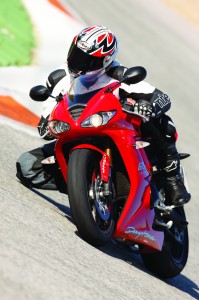
Triumph’s open-class sportbike, the in-line triple T595/955i Daytona produced from 1997-2006, was an interesting alternative to in-line fours and V-twins. The company three-peated and carved out its own niche in the supersports market with the 2006 release of the Triumph Daytona 675. It’s amazing what lopping-off one cylinder can do. Suddenly the clouds parted and a chorus of angels sang the new Daytona’s praises.
My love for the Triumph Speed Triple (1,050cc) is no secret. It impressed me at the 2008 Triumph model launch and it was my top choice in our liter-class sport standard comparison (2008 Kawasaki Z1000, Triumph Speed Triple and Yamaha FZ1 comparison review). A triple is not just an odd number of cylinders for cheekiness’ sake, it delivers a sweet spot experience; high-rpm power similar to an in-line four, plus robust torque like a V-twin.
With three consecutive Supertest shootout wins, two Masterbike supersport wins (and second place in 2008) and five European supersport championships, Triumph’s first-generation Daytona 675 has proven itself on the track. Adhering to the tight development cycle in this segment, Triumph started engineering the 2009 model only a few months after the first one was released in May 2006. The new model has been updated with more than 50 changes. Cue the highlight reel….
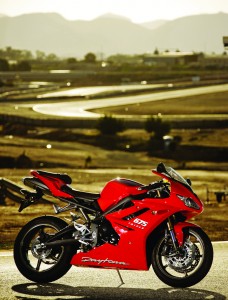
To achieve a claimed boost of three horsepower (from 123 to 126) and one additional lb-ft of torque (from 53 to 54), Triumph went to work on the cylinder head. New exhaust ports now have a constant expansion profile and oval exits for increased flow. Exhaust headers have been revised to match the new ports while losing more than a pound of weight by utilizing thinner materials. More than 2 pounds were saved by redesigning the elegant underseat exhaust, which also has improved flow and centralizes mass for better cornering agility. A magnesium cam cover shaved off another 0.6 pounds. New valves (30.5mm intake, 25.5mm exhaust) have narrower seats for less shrouding. Exhaust valve acceleration is reduced with a new longer-duration cam, and a hydraulic cam chain tensioner keeps things running smoothly. Shorter intake trumpets deliver higher top-end power. Together these changes allow a higher rev limit, from 13,500 rpm to 13,900 rpm in all gears. To handle the faster engine speed, the conrods have been made stronger and the crank and balance shafts have been modified. An updated engine control unit (ECU) ensures that all of the triple’s synapses fire harmoniously.
Fueling is unchanged, with the Keihin closed-loop fuel injection with 44mm throttle bodies and multi-spray injectors carried over from the previous model. EFI software has been calibrated for smoother response at low throttle openings. Ram air is inhaled through the Daytona’s snout and channeled directly through the headstock to the airbox. The ECU controls idle speed and the secondary air injection system, which lowers emissions.
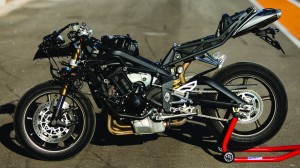
When we put the 2008 Speed Triple 1050 on Jett Tuning’s Dynojet dyno, it produced 120.6 horsepower (114.9 per liter) and 71.1 lb-ft of torque (67.7 per liter). On the same dyno, the 2009 Daytona 675 produced 108.7 horsepower (161.0 per liter) and 47.1 lb-ft of torque (69.8 per liter). The per-liter figures clearly indicate a high state of tune on the sportier middleweight. Power has been gained everywhere, especially on top. At its peak the new Daytona has gained three horsepower, yet it “revs out further and holds onto its power longer,” says Simon Warburton, Triumph’s Product Manager. “When you get near the rev limiter, you’re getting 8-9 more horsepower compared to the previous bike.”
Forgive the redundancy, but putting power to the ground is where the rubber meets the road. New Kayaba suspension and Pirelli tires handle this quite nicely. Compression damping now has high- and low-speed adjustability at both ends, for yet another sweet spot experience. Dial in the low-speed compression to handle aggressive braking and acceleration; calibrate high-speed compression to absorb sudden impacts like bumps. Firm, yet plush. Best of both worlds. Pirelli’s Diablo SuperCorsa SP tires provide World Supersport performance homologated for the street. They were very grippy on the track and the street, but I have my doubts about their high-mileage longevity or performance in the rain. More than 2 pounds of unsprung weight was saved using a lighter rear wheel and sprocket, reducing inertia by 20 percent for better acceleration and cornering. New Nissin monoblock front calipers deliver 15 percent more stopping power and 5 percent more bite (how do they measure that?), while new discs have improved heat distribution and dissipation. The aluminum frame and swingarm are unchanged from the previous model; ditto for steering geometry (23.9 degrees of rake, 3.51 inches of trail).
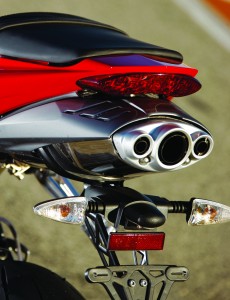
The world press introduction of the 2009 Triumph Daytona 675 was held in Cartagena, Spain, a city on the Mediterranean coast that was founded by the Carthaginians in 227 B.C. Although beautiful and historic, more important for our purposes was the region’s mild winter weather and the proximity of Circuito Cartagena, a 2.2-mile, 18-turn racetrack. We rode on the track one day and on the fast, sinuous public roads the next. Afterward, Triumph was kind enough to send us a test bike to enjoy in our own backyard.
Like the commercial says, you never get a second chance to make a first impression. Having logged seat time on the black-and-gold 2008 Daytona 675 LE, I had high expectations for the new model. Styling changes are subtle. The cockpit, windscreen and headlights have been massaged for a fresh look, and the engine cases are now black powdercoated. Two colors -Tornado Red and Jet Black-are devoid of racer-boy graphics. Overall, the bike is narrow of hip, with an aggressive, you-lookin’-at-me? countenance and a high, firm backside.
Starting the Daytona 675 on a cool December morning, the triple burbled to life and foggy exhaust emanated from the rear silencer. Reminiscent of its Speed Triple 1050 big brother, the deep baritone exhaust note is satisfying and mischievous. After one session to get familiar on the tight, technical Cartagena track, I very quickly got comfortable on the bike. Ergonomics are certainly sporty but humane (for the same motor and chassis in a standard package, Triumph offers the Street Triple R). My 34-inch-inseam legs had plenty of room and the reach to the clip-ons was manageable. A wide, flat seat makes it easy to move around and hang off, but it stops short of being sport-touring comfortable.

Instrumentation is similar to that on the Speed Triple, with an LCD speedo set within the bottom of the tachometer and another LCD display to the left showing engine temperature, gear position and time of day. Other functions include average and maximum speed (161 mph claimed), tripmeter and average and real-time fuel consumption. Triumph, please add a fuel gauge. Also, the buttons for changing modes are difficult to reach behind the cables. A programmable series of blue shift lights along the right side of the tachometer alerts you to approaching redline.
With a few horsepower and 6-7 lb-ft of torque up on most middleweight sportbikes, the Daytona 675 pulls very strongly and makes gear selection less critical. Adopted from last year’s race kit, the close-ratio, slick-shifting six-speed gearbox now has a taller first gear. The torque curve is very flat and has a narrow range. Drive off low-speed corners is exciting and WFO acceleration down the front straight of Circuito Cartagena was outstanding. When confronted with the sharp, uphill right-hander at Turn 1, the new Nissin radial-mount front calipers with radial master cylinder delivered precise feel and strong stopping power. With high-grip tires, well-calibrated suspension, responsive steering geometry and taut, balanced chassis, the Daytona 675 facilitates quick turn-in and steady line-holding. Cornering clearance is very generous; not once did the pegs make contact with the ground.
As awesome as the new Triumph is on the track, that’s not my bailiwick. I’m primarily a street rider, as are most of the folks who read this fine publication. And Triumph is primarily a street bike company. Race wins provide accolades and valuable development experience, but day-on, stay-on performance and livability are more important in the real world. And what a pleasure it was to be an American riding a British sportbike on Spanish roads. Yo bloody ole! Even on unfamiliar roads I felt more comfortable on the street than on the track, which made Day 2 much more enjoyable. Not only that, but I managed to lay claim to a bike with the accessory Arrow exhaust, which is lighter and delivers more bite without excessive bark.
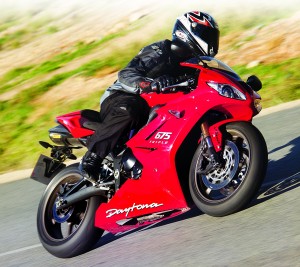
On tight roads in Spain and Southern California, the new Daytona 675 is a revelation. Phrases like “confidence-inspiring” and “feel like a hero” are over-used superlatives in moto-journalism. But sitting here writing rather than being out there riding, I am disconnected from the visceral, in-the-saddle experience. My notes include “when the chips are down, the 675 encourages me to go all in” and “in the heat of battle, I want the 675 in my foxhole.” I can hear the groans now. Suffice it to say, the bike is better than I am, and the experience leaves me breathless and word-poor.
For track days or club races, the accessory catalog includes a plug-n-play quick shifter, programmable race ECU with TRACS (Triumph RAce Calibration Software), Arrow rearsets and race exhaust and other go-fast parts. Many carbon fiber and anodized bits add a custom look, while comfort gel seats for rider and pillion (including a 10mm-lower seat option), tankbag and soft saddlebags provide touring amenities. A set of bar risers would be a welcome addition to the catalog.
For $9,799–the same price as the 2009 Honda CBR600RR and 2009 Kawasaki Ninja ZX-6R, but several hundred dollars less than the 2009 Suzuki GSX-R600 and 2009 Yamaha R6–Triumph gives you 76cc more bang for your buck and a unique riding experience. Perhaps channeling the spirit of fellow countrymen Monty Python’s And Now for Something Completely Different, the 2009 Daytona 675 will appeal to supersport riders who want their quality and performance leavened with unconventionality.
2009 Triumph Daytona 675 Review Spec Chart
Base Price: $9,799
Warranty: 2 yrs., unltd. miles
Website: www.triumph.co.uk/usa
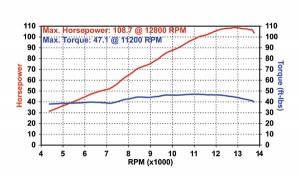 ENGINE
ENGINE
Type: Liquid-cooled, transverse in-line triple
Displacement: 675cc
Bore x Stroke: 74.0 x 52.3mm
Compression Ratio: 12.6:1
Valve Train: DOHC, 4 valves per cyl.
Valve Adj. Interval: 12,000 miles
Fuel Delivery: Multipoint sequential electronic fuel injection
Lubrication System: Wet sump, 3.2-qt. cap.
Transmission: 6-speed, cable-actuated wet clutch
Final Drive: O-ring chain
ELECTRICAL
Ignition: Digital inductive
Charging Output: 420 watts max.
Battery: 12V 8AH
CHASSIS
Frame: Aluminum beam twin spar
Wheelbase: 54.9 in.
Rake/Trail: 23.9 degrees/3.51 in.
Seat Height: 32.5 in.
Suspension, Front: 41mm Kayaba male-slider fork, fully adj. w/ high/low speed compression, 4.7-in. travel
Rear: Kayaba single shock, fully adj. w/ high/low speed compression, 5.1-in. travel
Brakes, Front: Dual 308mm floating discs w/ Nissin opposed 4-piston radial monoblock calipers & radial master cylinder
Rear: Single 220mm disc w/ Nissin 1-piston caliper
Wheels, Front: Cast, 3.50 x 17 in.
Rear: Cast, 5.50 x 17 in.
Tires, Front: 120/70-ZR17
Rear: 180/55-ZR17
Wet Weight: 422 lbs.
Load Capacity: 398 lbs.
GVWR: 840 lbs.
PERFORMANCE
Fuel Capacity: 4.6 gals., last 0.9 gal. warning light on
Average mpg: 35.8 / 89 octane min.
Estimated Range: 165 mi.
Indicated rpm at 60 mph: 5,000








